Tuoba
The Tuoba (Chinese) or Tabgatch (Old Turkic: 𐱃𐰉𐰍𐰲, Tabγač), also known by other names, was an influential Xianbei clan in early imperial China.
During the Sixteen Kingdoms after the fall of Han and the Three Kingdoms, the Tuoba established and ruled the Dai state in northern China. The dynasty ruled from 310 to 376 and then was restored in 386. The same year, the dynasty was renamed Wei, later distinguished in Chinese historiography as the Northern Wei. This powerful state gained control of most of northern China, supporting Buddhism while increasingly sinicizing. As part of this process, in 496, the Emperor Xiaowen changed the imperial clan's surname from Tuoba to Yuan (元). The empire split into Eastern Wei and Western Wei in 535, with the Western Wei's rulers briefly resuming use of the Tuoba name in 554.
| Tuoba | |||||||||||||||
|---|---|---|---|---|---|---|---|---|---|---|---|---|---|---|---|
| Traditional Chinese | 拓跋, 拓拔, 托跋, 托拔, 㩉拔 | ||||||||||||||
| Simplified Chinese | 拓跋 | ||||||||||||||
| |||||||||||||||

A branch of the Tanguts also bore a surname transcribed as Tuoba before their chieftains were given the Chinese surnames Li (李) and Zhao (趙) by the Tang and Song dynasties respectively. Some of these Tangut Tuobas later adopted the surname Weiming (嵬名), with this branch eventually establishing and ruling the Western Xia in northwestern China from 1038 to 1227.
Names
By the 8th century, the Old Turkic form of the name was Tabγač (𐱃𐰉𐰍𐰲), usually anglicized as Tabgatch or Tabgach. The name appears in other Central Asian accounts as Tabghāj and Taugash and in Byzantine Greek sources like Theophylact Simocatta's History as Taugas (Greek: Ταυγάς) and Taugast (Ταυγάστ). Zhang Xushan and others have argued for the name's ultimate derivation from a transcription into Turkic languages of the Chinese name "Great Han" (大漢, s 大汉, Dà Hàn, MC *Dàj Xàn).
Tuoba is the atonal pinyin romanization of the Mandarin pronunciation of the Chinese 拓跋 (Tuòbá), whose pronunciation at the time of its transcription into Middle Chinese has been reconstructed as *tʰak-bɛt[citation needed] or *Thak-bat. The same name also appears with the first character transcribed as 托 or 㩉 and with the second character transcribed as 拔;[citation needed] it has also been anglicized as T'o-pa and as Toba. The name is also attested as Tufa (禿髮, Tūfà or Tūfǎ), whose Middle Chinese pronunciation has been reconstructed as *tʰuwk-pjot,[citation needed] *T'ak-bwat, or *T'ak-buat. The name is also sometimes clarified as the Tuoba Xianbei (拓跋鮮卑, Tuòbá Xiānbēi).
Ethnicity and language
According to Hyacinth (Bichurin), an early 19th-century scholar, the Tuoba and their Rouran enemies descended from common ancestors. The Weishu stated that the Rourans were of Donghu origins and the Tuoba originated from the Xianbei, who were also Donghu's descendants. The Donghu ancestors of Tuoba and Rouran were most likely proto-Mongols. Nomadic confederations of Inner Asia were often linguistically diverse, and Tuoba Wei comprised the para-Mongolic Tuoba as well as assimilated Turkic peoples such as Hegu (紇骨) and Yizhan (乙旃); consequently, about one quarter of the Tuoba tribal confederation was composed of Dingling elements as Tuoba migrated from northeastern Mongolia to northern China.
Alexander Vovin (2007) identifies the Tuoba language as a Mongolic language. On the other hand, Juha Janhunen proposed that the Tuoba might have spoken an Oghur Turkic language. René Grousset, writing in the early 20th century, identifies the Tuoba as a Turkic tribe. According to Peter Boodberg, a 20th-century scholar, the Tuoba language was essentially Turkic with Mongolic admixture. Chen Sanping observed that the Tuoba language contains both elements. Liu Xueyao stated that the Tuoba may have had their own language which should not be assumed to be identical with any other known languages. Andrew Shimunek (2017) classifies Tuoba (Tabghach) as a "Serbi" (i.e., para-Mongolic) language. Shimunek's Serbi branch also consists of the Tuyuhun and Khitan languages.
History




The Tuoba were a Xianbei clan. The distribution of the Xianbei people ranged from present day Northeast China to Mongolia, and the Tuoba were one of the largest clans among the western Xianbei, ranging from present day Shanxi province and westward and northwestward. They established the state of Dai from 310 to 376 AD and ruled as the Northern Wei from 386 to 536. The Tuoba states of Dai and Northern Wei also claimed to possess the quality of earth in the Chinese Wu Xing theory. All the chieftains of the Tuoba were revered as emperors in the Book of Wei and the History of the Northern Dynasties.
The Northern Wei started to arrange for Chinese elites to marry daughters of the Xianbei Tuoba royal family in the 480s. More than fifty percent of Tuoba Xianbei princesses of the Northern Wei were married to southern Chinese men from the imperial families and aristocrats from southern China of the Southern dynasties who defected and moved north to join the Northern Wei. Some Chinese exiled royalty fled from southern China and defected to the Xianbei. Several daughters of the Xianbei Tuoba Emperor Xiaowen of Northern Wei were married to Chinese elites: the Han Chinese Liu Song royal Liu Hui married Princess Lanling of the Northern Wei; Princess Huayang married Sima Fei, a descendant of Jin dynasty (266–420) royalty; Princess Jinan married Lu Daoqian; and Princess Nanyang married Xiao Baoyin (萧宝夤), a member of Southern Qi royalty. Emperor Xiaozhuang of Northern Wei's sister the Shouyang Princess was wedded to Emperor Wu of Liang's son Xiao Zong. One of Emperor Xiaowu of Northern Wei's sisters was married to Zhang Huan, a Han Chinese, according to the Book of Zhou (Zhoushu). His name is given as Zhang Xin in the Book of Northern Qi (Bei Qishu) and History of the Northern Dynasties (Beishi) which mention his marriage to a Xianbei princess of Wei. His personal name was changed due to a naming taboo on the emperor's name. He was the son of Zhang Qiong.
When the Eastern Jin dynasty ended, Northern Wei received the Han Chinese Jin prince Sima Chuzhi as a refugee. A Northern Wei Princess married Sima Chuzhi, giving birth to Sima Jinlong (司馬金龍). Northern Liang Xiongnu King Juqu Mujian's daughter married Sima Jinlong.
Genetics
According to Zhou (2006) the haplogroup frequencies of the Tuoba Xianbei were 43.75% haplogroup D, 31.25% haplogroup C, 12.5% haplogroup B, 6.25% haplogroup A and 6.25% "other."
Zhou (2014) obtained mitochondrial DNA analysis from 17 Tuoba Xianbei, which indicated that these specimens were, similarly, completely East Asian in their maternal origins, belonging to haplogroups D, C, B, A and haplogroup G.
Chieftains of Tuoba Clan 219–376 (as Princes of Dai 315–376)
| Posthumous name | Full name | Period of reign | Other |
|---|---|---|---|
| 神元 Shényuán | 拓拔力微 Tuòbá Lìwéi | 219–277 | Temple name: 始祖 Shízǔ |
| 章 Zhāng | 拓拔悉鹿 Tuòbá Xīlù | 277–286 | |
| 平 Píng | 拓拔綽 Tuòbá Chuò | 286–293 | |
| 思 Sī | 拓拔弗 Tuòbá Fú | 293–294 | |
| 昭 Zhāo | 拓拔祿官 Tuòbá Lùguān | 294–307 | |
| 桓 Huán | 拓拔猗㐌 Tuòbá Yītuō | 295–305 | |
| 穆 Mù | 拓拔猗盧 Tuòbá Yīlú | 295–316 | |
| None | 拓拔普根 Tuòbá Pǔgēn | 316 | |
| None | 拓拔 Tuòbá | 316 | |
| 平文 Píngwén | 拓跋鬱律 Tuòbá Yùlǜ | 316–321 | |
| 惠 Huì | 拓拔賀傉 Tuòbá Hèrǔ | 321–325 | |
| 煬 Yáng | 拓拔紇那 Tuòbá Hénǎ | 325–329 and 335–337 | |
| 烈 Liè | 拓拔翳槐 Tuòbá Yìhuaí | 329–335 and 337–338 | |
| 昭成 Zhaōchéng | 拓拔什翼健 Tuòbá Shíyìjiàn | 338–376 | Regnal name: 建國 Jiànguó |
Legacy

As a consequence of the Northern Wei's extensive contacts with Central Asia, Turkic sources identified Tabgach, also transcribed as Tawjach, Tawġač, Tamghaj, Tamghach, Tafgaj, and Tabghaj, as the ruler or country of China until the 13th century.
The Orkhon inscriptions in the Orkhon Valley in modern-day Mongolia from the 8th century identify Tabgach as China.
I myself, wise Tonyukuk, lived in Tabgach country. (As the whole) Turkic people was under Tabgach subjection.
In the 11th century text, the Dīwān Lughāt al-Turk ("Compendium of the languages of the Turks"), Turkic scholar Mahmud al-Kashgari, writing in Baghdad for an Arabic audience, describes Tawjach as one of the three components comprising China.
Ṣīn [i.e., China] is originally three fold: Upper, in the east which is called Tawjāch; middle which is Khitāy, lower which is Barkhān in the vicinity of Kashgar. But now Tawjāch is known as Maṣīn and Khitai as Ṣīn.
At the time of his writing, China's northern fringe was ruled by Khitan-led Liao dynasty while the remainder of China proper was ruled by the Northern Song dynasty. Arab sources used Sīn (Persian: Chīn) to refer to northern China and Māsīn (Persian: Machīn) to represent southern China. In his account, al-Kashgari refers to his homeland, around Kashgar, then part of the Kara-Khanid Khanate, as Lower China. The rulers of the Karakanids adopted Tamghaj Khan (Turkic: the Khan of China) in their title, and minted coins bearing this title. Much of the realm of the Karakhanids including Transoxania and the western Tarim Basin had been under the rule of the Tang dynasty prior to the Battle of Talas in 751, and the Karakhanids continued to identify with China, several centuries later.
The Tabgatch name for the political entity has also been translated into Chinese as Taohuashi (Chinese: 桃花石; pinyin: táohuā shí). This name has been used in China in recent years to promote ethnic unity.
See also
References
Citations
This article uses material from the Wikipedia English article Tuoba, which is released under the Creative Commons Attribution-ShareAlike 3.0 license ("CC BY-SA 3.0"); additional terms may apply (view authors). Content is available under CC BY-SA 4.0 unless otherwise noted. Images, videos and audio are available under their respective licenses.
®Wikipedia is a registered trademark of the Wiki Foundation, Inc. Wiki English (DUHOCTRUNGQUOC.VN) is an independent company and has no affiliation with Wiki Foundation.